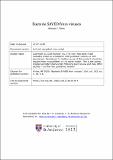Files in this item
Bacteria SAVED from viruses
Item metadata
| dc.contributor.author | White, Malcolm F. | |
| dc.date.accessioned | 2021-07-08T23:37:56Z | |
| dc.date.available | 2021-07-08T23:37:56Z | |
| dc.date.issued | 2020-07-09 | |
| dc.identifier | 269159300 | |
| dc.identifier | 94ee1d19-fd2f-478f-8c97-01de84de1745 | |
| dc.identifier | 85087423197 | |
| dc.identifier | 000549184500022 | |
| dc.identifier.citation | White , M F 2020 , ' Bacteria SAVED from viruses ' , Cell , vol. 182 , no. 1 , pp. 5-6 . https://doi.org/10.1016/j.cell.2020.06.015 | en |
| dc.identifier.issn | 0092-8674 | |
| dc.identifier.other | ORCID: /0000-0003-1543-9342/work/77524480 | |
| dc.identifier.uri | https://hdl.handle.net/10023/23502 | |
| dc.description.abstract | Increasingly, cyclic nucleotide second messengers are implicated in antiviral defense systems in bacteria and archaea as well as in eukaryotes. In this issue of Cell, Lowey et al. describe SAVED—a widespread, uncharacterized cyclic nucleotide sensor protein domain that activates cell defense systems. The structure of SAVED reveals links to the CRISPR system, which also generates cyclic nucleotides in response to viral infection. | |
| dc.format.extent | 2 | |
| dc.format.extent | 877360 | |
| dc.language.iso | eng | |
| dc.relation.ispartof | Cell | en |
| dc.subject | QH301 Biology | en |
| dc.subject | QR355 Virology | en |
| dc.subject | Biochemistry, Genetics and Molecular Biology(all) | en |
| dc.subject | T-NDAS | en |
| dc.subject.lcc | QH301 | en |
| dc.subject.lcc | QR355 | en |
| dc.title | Bacteria SAVED from viruses | en |
| dc.type | Journal article | en |
| dc.contributor.institution | University of St Andrews. School of Biology | en |
| dc.contributor.institution | University of St Andrews. Biomedical Sciences Research Complex | en |
| dc.identifier.doi | https://doi.org/10.1016/j.cell.2020.06.015 | |
| dc.description.status | Peer reviewed | en |
| dc.date.embargoedUntil | 2021-07-09 | |
| dc.identifier.url | https://www.cell.com/cell/fulltext/S0092-8674(20)30746-7 | en |
This item appears in the following Collection(s)
Items in the St Andrews Research Repository are protected by copyright, with all rights reserved, unless otherwise indicated.

